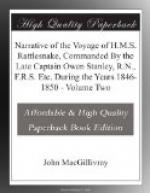(Footnote. In illustration of the difficulty of framing so apparently simple a document as a vocabulary, and particularly to show how one must not fall into the too common mistake of putting down as certain every word he gets from a savage, however clearly he may suppose he is understood, I may mention that on going over the different parts of the human body, to get their names by pointing to them, I got at different times and from different individuals—for the shin-bone, words which in the course of time I found to mean respectively, the leg, the shin-bone, the skin, and bone in general.)
The physical characteristics of these Australians seen at Cape York differ in no respect from those of the same race which I have seen elsewhere. The absence of one or more of the upper incisors was not observed here, nor had circumcision or any similar rite been practised, as is the case in some parts of the continent. Among these undoubted Australians were, as already mentioned, two or three Papuans. They differed in appearance from the others in having the skin of a much lighter colour—yellowish brown instead of nearly black—the hair on the body woolly and growing in scattered tufts, and that of the head also woolly and twisted into long strands like those of a mop. On the right shoulder, and occasionally the left also, they had a large complicated, oval scar, only slightly prominent, and very neatly made.
The custom of smoking, so general throughout Torres Strait, has been introduced at Cape York. Those most addicted to it were the Papuans above-mentioned, but many of the Australians joined them, and were equally clamorous for tobacco. Still it was singular to notice that although choka (tobacco) was in great demand, biscuit, which they had corrupted to bishikar, was much more prized. Their mode of smoking having elsewhere* been described, I need not allude to it further than that the pipe, which is a piece of bamboo as thick as the arm and two or three feet long, is first filled with tobacco-smoke, and then handed round the company seated on the ground in a ring—each takes a long inhalation, and passes the pipe to his neighbour, slowly allowing the smoke to exhale. On several occasions at Cape York I have seen a native so affected by a single inhalation, as to be rendered nearly senseless, with the perspiration bursting out at every pore, and require a draught of water to restore him; and, although myself a smoker, yet on the only occasion when I tried this mode of using tobacco, the sensations of nausea and faintness were produced.
(Footnote. Jukes’ Voyage of the Fly Volume 1 page 165.)




